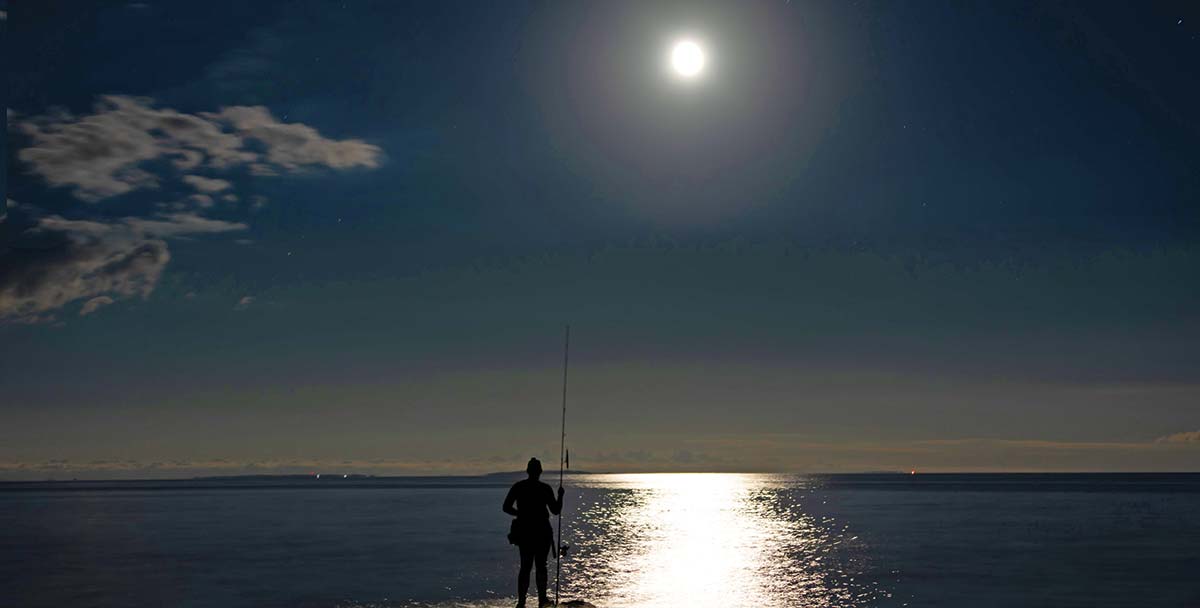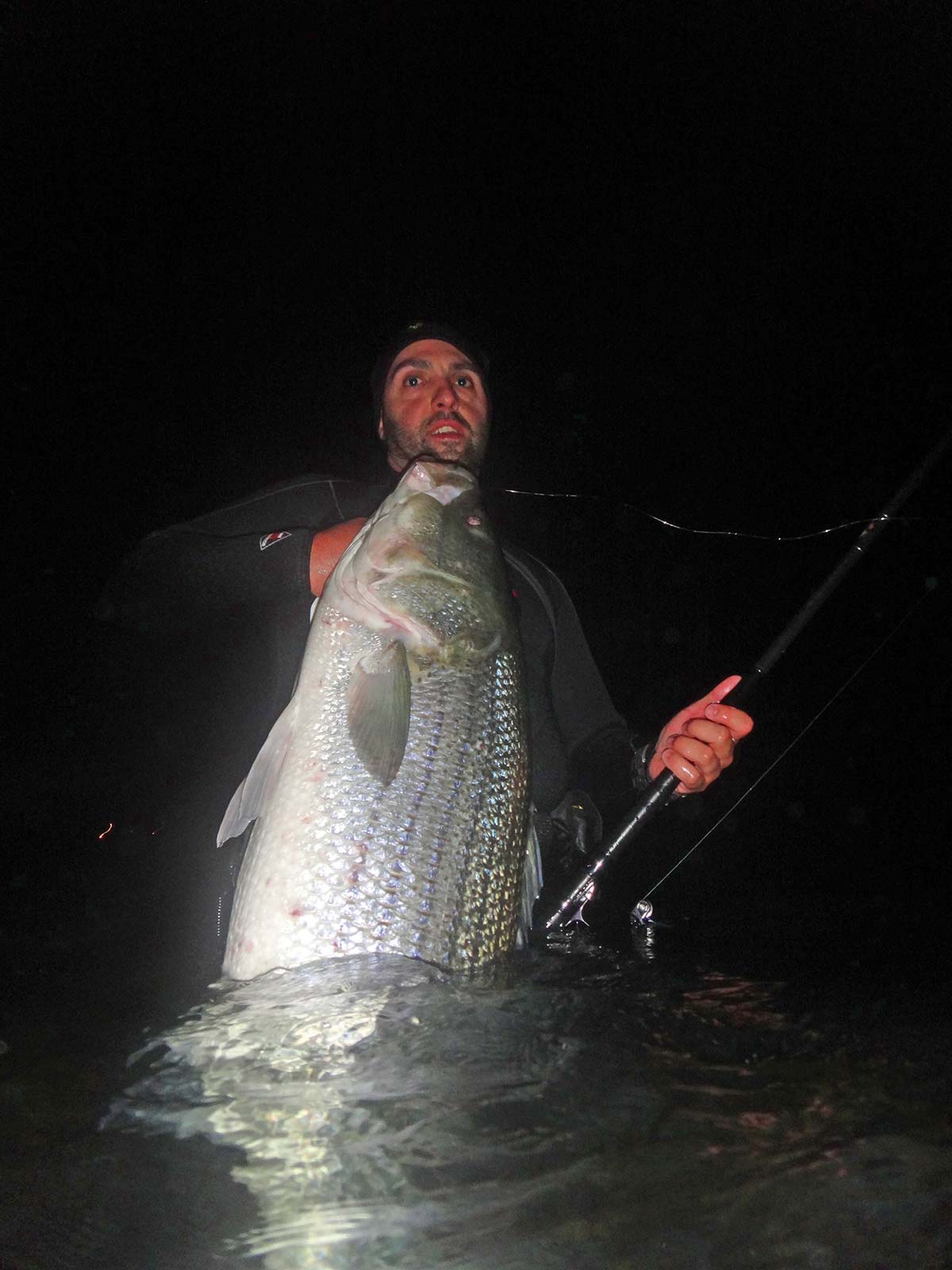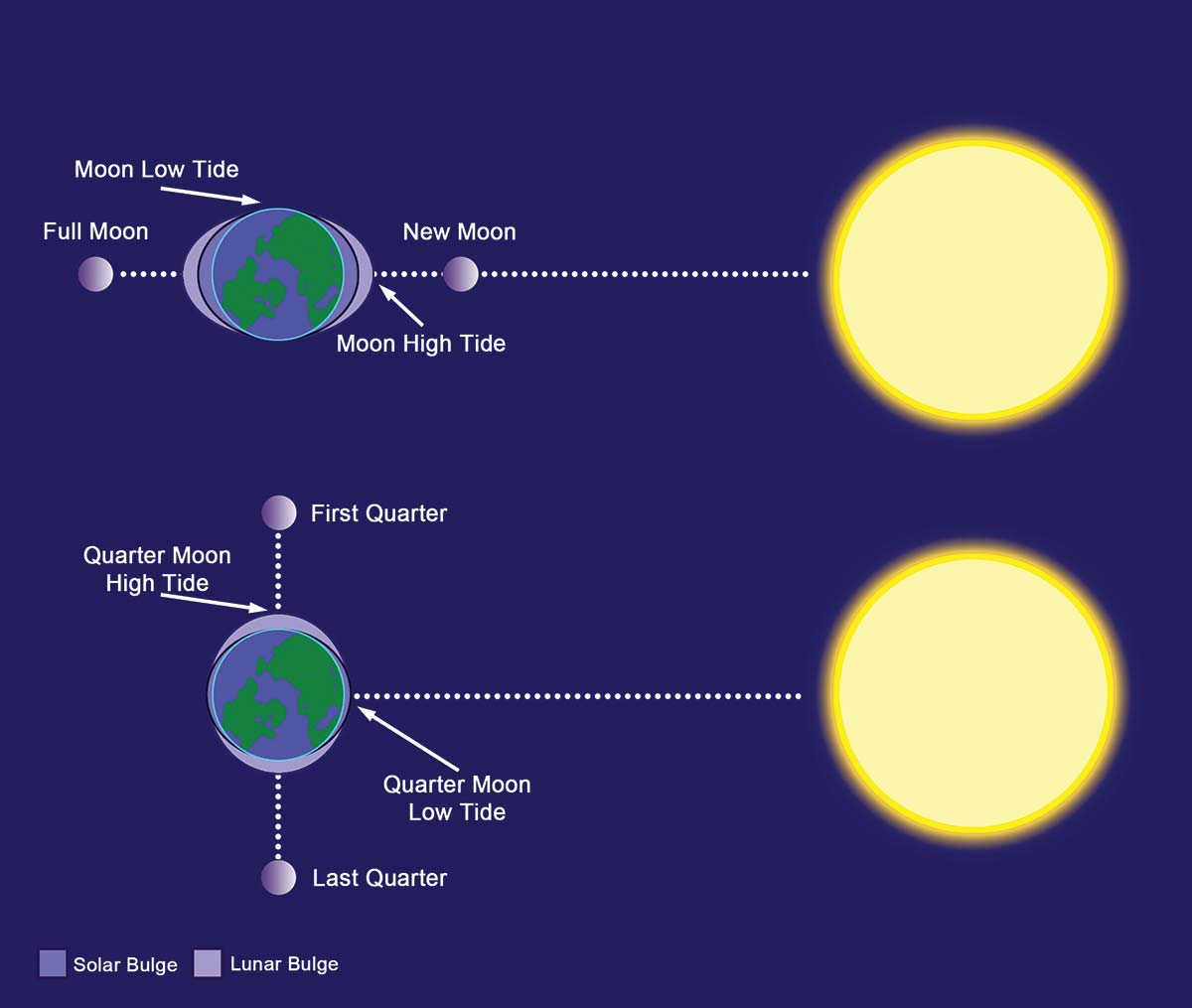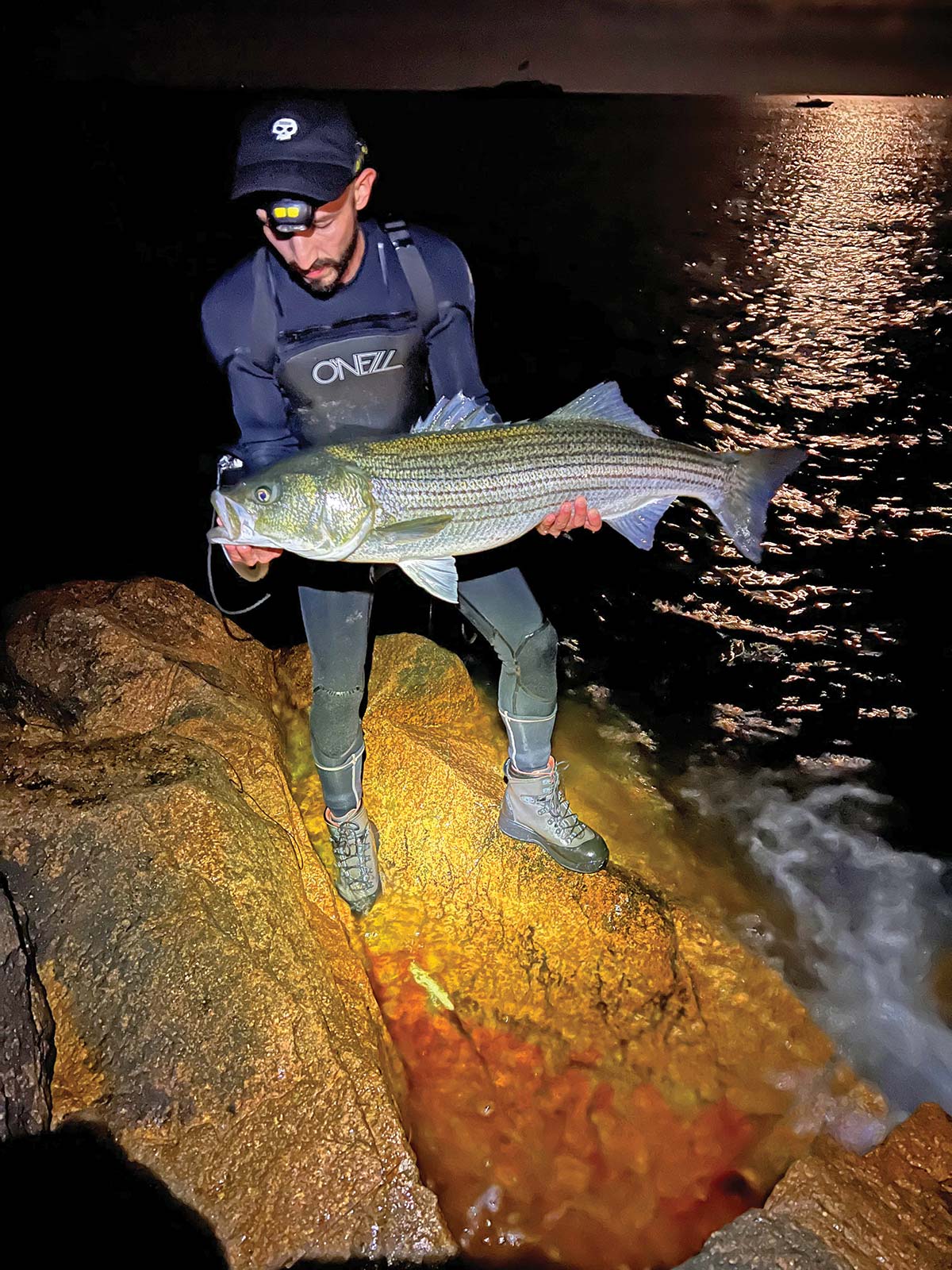
Striper fishermen, as a group, have to be one of the most moon-centric segments of the angling community. It is true, that the moons play a role in many fisheries, fresh and salt, and it is definitely worthy and useful to track your fishing success and plot it within the cycles of the moon. In most cases, you’re going to find spikes around the new and/or full moon periods. An exception might be deep water groundfishing where moon currents force anglers to fish tight windows of slower water, so that their rigs can reach bottom without scoping out. But if you’re a striped bass fisherman, and especially if you’re a surfcaster, fishing success and lunar phase are very likely to be closely linked.
There are many reasons why moons ignite striper action. I’ve even heard some wild-eyed anglers claim that the cosmic forces of a full or new moon make the bass do crazy things, in the same way that emergency rooms tend to see a steep spike in admissions during these periods. I can’t claim to know much about cosmic forces or striper astrology, but I can tell you that the moons matter; in light and dark and in the strength of the tides they produce.
Tides For Laymen
The concept of a moving tide is actually a bit of a misnomer, you may know that the moon drives the tides, and you have likely observed that full and new moons produce the greatest changes in water depth between high and low tide. This fact has nothing to do with how much of the moon is or isn’t hidden beneath the shadow of the earth. It also has nothing to do with the moon’s alignment within the sphere or shadow of the earth. The moon is about 27% of the size of our planet, and therefore its influence on things down here can only be affected by its distance from us. The moon is captured by earth’s gravity and therefore it can’t race ahead of us or fall behind. But that’s not even the chief factor in why the full and new moon tides move so much more water, although supermoons (full or new moons that coincide with perigee) will produce some amazingly high and low tides.
The moon’s orbit, just like nearly all natural orbits, is elliptical and even its orbit slowly rotates on an 18 year cycle around the earth like a giant hula hoop—this is why supermoons seem to have no discernable pattern to those of us who don’t have a master’s degree in astronomy. The gravitational forces of the earth and the moon are traded back and forth in a constant flow of magnetic attraction. But there’s a third player in this equation: the sun. It’s easy to forget that the earth is captured within the gravitational pull of the sun and twice during each 28 day trip the moon takes around the earth, the sun and moon work together to create stronger tides.
The tide is a product of the gravitational forces of the moon (and sun) pulling the liquid ocean out and away from the solid earth. If you can picture the ocean as an elastic substance, the moon attracts the ocean with its gravity, creating a bulge which creates one high tide, the moon also pulls the earth closer, leaving a bulge on the other side of the earth—this is why there are two high tides per day. When the sun and moon oppose each other or align, the tides are even greater because the bulges are augmented by the multiplied forces of each celestial body. Neap tides occur when the moon and sun are roughly 90 degrees from each other, the moons influence on the water is negated to some degree by the smaller bulge being created by the sun—this is why the heights of the low and high tides are much closer together during the quarter moons. The lunar and solar bulges are working against each other.
Tidal currents are a product of the earth rotating ‘underneath’ these gravity bulges along with the bottom and shoreline contours. How cool is that?! The ocean is static and it’s the movement of the earth that creates what we perceive as tidal current!

Light & Dark
Another component of the moons that striper fishermen key in on is the amount of available natural light. Surfcasters in particular, are often fixated on the periods surrounding the new moons because they promise a stretch of very dark nights. There are a whole set of accepted reasons why this is better for a surfcaster, the most widely touted being that a dark night makes a big fish feel safer because she feels hidden from larger predators thanks to the darkness. I won’t say that I don’t prefer new moons, because I absolutely do. But I struggle with the reasoning because I have had some good luck with large fish in daylight from the surf, albeit mostly on cloudy days. By the same token, my success on clear nights with a big, bright moon, has been varied at best. This has left me wondering if it’s light penetration that’s the true culprit. Many hardcore boat anglers that I have spoken with about this subject say they love the full moons for fishing deep rips or eeling ledges in 40-plus feet of water. Could it be that a clear sky with a bright sun or a bright moon makes it harder for stripers to ambush prey in shallow water?
We know that striped bass have some understanding of light and shadow because they are known to exploit bridge shadows as an artificial ambush point. As bright as the noonday sun may seem, there’s just something about the ‘black hole’ darkness of a shadow in the silvery light of a full moon, which would lead me to believe that the shadows cast by predatory fish moving through shallow water during a bright moon period might forewarn their prey, making ambush very difficult or even impossible. One big ‘eureka’ moment came to me thanks to a conversation with field editor John Hanecak, he said that he focuses on areas with big boulders or ledges during the full moons because the shadows cast by these underwater obstructions give the stripers a place to hide from the light. An image of a shadowy boulder field manifested in my mind and it all made such beautiful and perfect sense.

Moon Mathematics
Not every full and new moon is created equal either, the best tide charts will list numbers next to each tide timing, these are their forecasted heights. Up here in southern New England where I fish, high tides typically range between 2.8 and 4.5 feet—the 2.8 would be around quarter moon and the 4.5 would fall on the new or full moon. But sometimes we see tide heights as high as 5 feet. Low tides are usually listed between 0.8 and 0.1 this is their deviation from the average low water mark, but you will sometimes see them dropping into the negative, these periods of stronger celestial influence are called minus tides.
This is where my excitement for moon periods stems from. A higher tide excites me for two reasons, there will be more water covering any spot that I think of as a high water spot, which typically means the fish will stay in there longer (and sometimes means bigger fish will venture in as well). If we have an especially big tide, then it’s quite likely that there will be a corresponding minus tide six hours later. When more water than normal is moving in and less water that normal will be left when the tide is all the way out, all that means to me is more water movement has to happen in between. More water moving means currents are running harder, more baitfish are being flushed out, translating to more opportunities for predatory fish and striped bass are going to take advantage. Harder-running currents also mean that your plug will be moving through a more tumultuous feeding zone which increases the chances that a large, wary fish will make a mistake and eat it, simply because they have less time to decide whether or not to strike.

If 6 Was 9
Luckily for us, the tide levels run on a curve, not unlike an ocean wave. So we don’t only get one day of increased tidal activity right on the moon. I look at each moon cycle as a nine day opportunity; four days before, the day of the moon itself and four days after. These days can be roughly graded by their proximity to the biggest tide of the cycle. But don’t fall too hard for grading each of these nine days for their ‘on paper’ potential. Each of these nine days has a higher probability than the five on either end, instead grade them by the forecast or just fish them all!
It’s not uncommon to hear surfcasters talking about ‘tide windows’, these are segments within a tide cycle when certain locations are more likely to produce fish. There are many factors that contribute to these windows and I have spots that produce their best results at all different stages and on the ebb and flood. I say this because many novice casters assume that their spots are going to fish best around tide changes, but this is not always the case. There are ways to read a spot and make educated guesses, but if you want to actually know the facts about a given location, you have to fish it hard over a period of years.
Some spots require a high moon tide because they are shallow and expansive and a higher tide basically ‘opens the gate’ giving fish the comfort to enter a spot that might otherwise be too shallow. Another reason a high moon tide might be the correct timing is that weaker tides don’t move hard enough to set up a rip that attracts fish for a few nights in each tide cycle. But not all shallow spots fish best at high tide, sometimes you need that tide to come down enough that the longshore current is going to be squeezed through that shallow zone, setting up a two hour opportunity before the tide empties out and pushes the fish beyond casting range. But even the bottom portions of a minus tide have their positives, maybe providing access to a hole or reef that you can’t reach at other times, or a bottomed out tide may force fish to ‘spill off’ into the deepest spots making them easier to target. Many anglers exploit this phenomenon on sand beaches with pronounced bars and troughs—lower tides make it easier to discern where the fish are most likely to be.
I always find that I have my best success when I apply logic to the way I fish and how I choose where to fish. Logic requires something we can rely on to make baseline decisions, and the moons and tides are really the only reliable variables in striped bass fishing. If you can get yourself to think of the tides as water depth as well as water movement, you’ll be making huge steps in the right direction. Layer in the strength and power of the moons and you’ll leave your former self in the dust.




